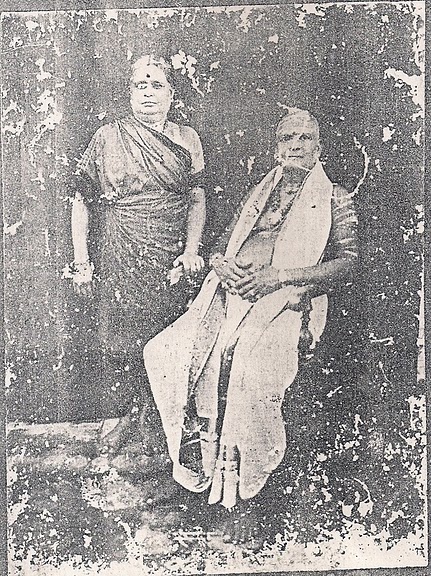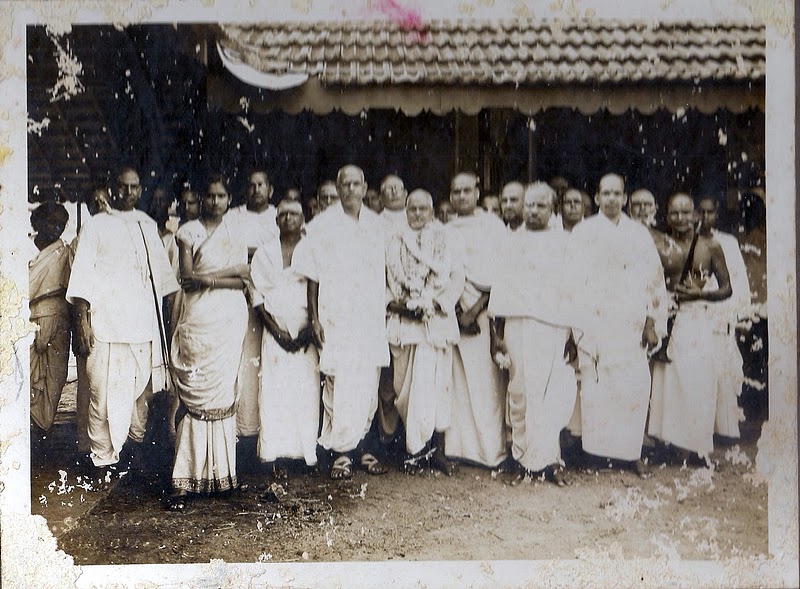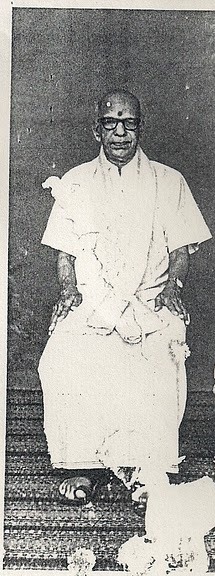AnandaRama Udupa is the author of guruguha gana vaibhava a compilation of two volumes of all available kritis attributed to Dikshitar. He is a musicologist and is in
Bangalore. He also sings all the compositions.. He passed away in Bangalore December 2010.
Could you tell us about your background in music?
My father Krishna Udupa was a musician.He was a vocalist and also a violinist in our native district South Kanara. My elder brother Srinivasa Udupa was also a musician, violinist, musicologist and a good teacher. I learnt from both of them. I received advanced training in music from flute vidwan N.Gopalakrishnan, the Principal of Kalaniketana art school in Mangalore. The musical atmosphere at home developed an interest in me. Furthermore , I had a good swara jnana even in my teenage. This helped me practice the kritis once heard, provided I got the full text with notation. However, I did not take to music for my livelihood. I joined the Postal department in 1951. I am living in Bangalore since 1964 and had many an opportunity of listening to vidwans of repute.
When and how did your interest in Dikshitar kritis develop?
In my schooldays I learnt Sanskrit. Particularly the Sanskrit sahitya of Dikshitar’s kritis fascinated me. In the beginning I had a desire to learn the the Navagraha and Navavarana kritis of Dikshitar. I learnt Tamil and bought books. I learnt a few kritis on Vinayaka also, besides Navagraha and Navavarana. In the mean time , I got all the available kritis of Dikshitar, transcribed them into Kannada. Learnt group songs on Subramanya, Balamba, Panchalinga and so on. I then got a desire to practice all the remaining kritis. Every day I would sing one from each group for about an hour. The practice continued for several years from 1966 onwards. Music is my hobby. I had no time bound programme to learn. Over the years and up till now, I have collected more than 3500 songs of different vaggeyakaras in notation in Kannada and have preserved them in bound books. With a base of swara and raga jnana, knowledge of gamakas in those ragas, one can try and sing compositions from notation. Constant practice and listening to good music, preferably live concerts, will definitely improve one’s knowledge and ability to sing.
How did you think of publishing a book and in Kannada ?
This is the background of my books. Sruti Ranjani is an organization in Bangalore devoted to propagation of classical and devotional music founded by Late Abhayam Raju in 1975. She had published in Tamil, the kritis of vaggeyakara Meenakshisuta. After her demise in 1984. Prof T.A.Raju (her husband) took up the work of Sruti Ranjani. He asked me to translate the kritis of Meenakshisuta from Tamil to Kannada. My Kannada translation of the book was published in 1989. The left over kritis of Meenakshisuta, about 20, which were only in cassettes sung by the vaggeyakara himself, were notated by me (exactly as sung by the composer) and was published both in Kannada and Tamil by Sruti Ranjani in 1997. A reprint of the older book (vol1) by Abhayam Raju in Tamil was also later printed in my own handwriting (Tamil). Thus I was closely associated with the work of Sruti Ranjani. Prof T.A. Raju of SrutiRanjani knew that I had a deep interest in Dikshitar’s kritis. He mooted the idea of a book of Diksitar’s kritis. I told him an ideal thing would be to publish the complete works of Dikshitar in Kannada , so far not dome by others, but the printing work would run to more than 1200 pages entailing huge cost. Prof Raju did not hesitate and did this monumental work if I may say so, completely financing the project from his pocket. The 2 big volumes of the book titled “GURUGUHA GANA VAIBHAVA” of about 1280 pages were printed in CLI Press of Chennai-17, and was released in Bangalore on Oct 7, 2000. But very unfortunately Prof Raju passed away on Dec 15, 2000. A very touching obituary was given to this great man in the SRUTI ( music magazine) of Chennai in Feb 2001.In the obituary article by P.ORR, SRUTI says Typically , Prof Raju gave virtually all the credit for the new publication to Anandarama Udupa by describing it as a ‘colossal work of a single man’. Nonetheless it was he who produced this compendium as well as the previous Meenakshisuta kritis financing them entirely out of his own pocket and without a commercial angle. Sangeeta kala Acharya Sri T.S.Parthasarathy Fellow Sangeet Natak Academy & Emeritus Fellow Dept of culture, Govt. of India writes about the book,
There are many unique features about the book. First of all the ‘MUNNUDI’ and Dikshitara kritigala artha vaibhava by Prof. S.K.Ramachandra Rao,the ‘living legend’ of Karnataka have added great value and prestige to the publication. Secondly, the calligraphy by vidwan Anandarama Udupa who is perhaps the only person in India who can write a 1200 pages book in his own handwriting which is prettier than print. I happened to know this musicologist whose services I requisitioned sometime ago for translating some ‘Padagalu’
of Purandaradasa for a publication here…….
You have calligraphed 1200 pages of the book. How long did this work take you?
I wrote the book in my own handwriting mainly to avoid printing mistakes. Only the foreword and special meanings of kritis by Prof. Rao, Dikshitar’s life, index etc were done by DTP. Two volumes containing about 1280 pages have been moderately priced at Rs.675/-. The calligraphy took me well over a year. But the job was very well satisfying.
How did you learn all the 479 kritis of/attributed to Dikshitar ?
I learnt the 476 kritis of Dikshitar appearing in our book (2vols) as a sort of daily ritual/routine. I used to sing everyday at least one Ganesha kriti ,one Navagraha,one Navavarana/Balamba vibhakti kriti, one on Subramanya/Shiva /Shive etc. This practice continued for years. This gave me a clear insight into singing this great Master’s compositions- the grandeur of the Sanskrit Sahitya he employed, their unparalleled lyrical beauties, raga
portrayal etc.
Do you teach music ?
I am not a professional musician. I retired from Govt service in 1987. I am not a regular teacher also, even though I taught Navagraha,Navavarana and few other kritis here and there. I have been writing articles on Dikshitar’s music and giving lecture demonstrations on his rare kritis,lyrical beauty of Sahitya in them etc.
The talas in the sampradaya pradarshini and those in other publications differ. How did you reconcile both?
Dikshitar’s kritis given in SSP (or for that matter ,any kriti in SSP) are full of gamaka signs not very easily understandable. Without a good knowledge of gamakas and ‘anuswaras’ going with a note or swara, it is difficult to visualize a correct picture of the notation. But in the modern way of writing notation, the number of akshara kalas for an avarta are double or even quadruple sometimes. To sight an example, instead of 8+4+4 in Adi Tala, (usually employed in SSP) we write 16+8+8, making it easier to sing from notation. Talas given in SSP have not changed but only the aksharakalas in a beat have changed according to the anuswaras employed by the main swara. Here permit me to say that Dikshitar kritis have to be sung with a thorough knowledge of gamakas that may appear in a particular raga, a good grip over vilamba kala. Clear and correct pronunciation of Sahitya with due care for alpaprana/ mahaprana in syllables without wrong emphasis or unnecessary elongation of syllables giving way to distortion of lyrics, without splitting the words or phrases at wrong places and thus keeping up the beauty of the composition on the whole.
There are various pathantaras ? Which one did you follow?
According to justice T.L.Venkatrama Iyer , the versions of Subbarama Dikshitar and his disciples can be considered most authentic. Kallidaikurichi schools and Anantha Krishna Iyer schools (Calcutta) have done a magnificent service to the music world by publishing the kritis available today. Two kritis not printed in any book so far , but
accredited to Dikshitar by the Kolkata school (Ganapate Mahamate in Kalyani and Gopika Manoharam in Mohana) have been printed in our book. Versions of Rangaramanuja Iyengar in Kritimanimalai appear to be slightly different in patanthara as the author belonged to the school of Veena Dhanammal. However, I have adopted the former patanthara;but have taken from RRI only the different patanthara of Chittaswara or Solkattu swara wherever available (I have given both the patantharas of them for reference). Arohanas and Avarohanas of ragas are given as found in SSP, the versions of Venkatamakhi. Melakarta raga numbers are indicated. Any present day change in Aroha and Avaroha are indicated in brackets.
How did you feel after compiling the book?
Writing the whole book was a challenging task. I wrote out the kritis also humming the tunes. It was a satisfying experience too. Compilation of the book has given me a great sense of fulfilment, a life’s ambition. Dikshitar’s kritis are great in every sense of the term; we may have to understand or assess their beauty according to our capacity or limitations.”Endaro Mahanubavulu”.I am deeply indebted to Prof.S.K.Ramachandra Rao who blessed my book with his scholarly foreword and meanings in a separate part 3 of the book, the hidden meanings of selected compositions.




